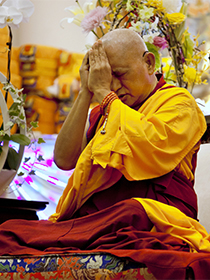- Home
- FPMT Homepage

Foundation for the Preservation of the Mahayana Tradition
The FPMT is an organization devoted to preserving and spreading Mahayana Buddhism worldwide by creating opportunities to listen, reflect, meditate, practice and actualize the unmistaken teachings of the Buddha and based on that experience spreading the Dharma to sentient beings. We provide integrated education through which people’s minds and hearts can be transformed into their highest potential for the benefit of others, inspired by an attitude of universal responsibility and service. We are committed to creating harmonious environments and helping all beings develop their full potential of infinite wisdom and compassion. Our organization is based on the Buddhist tradition of Lama Tsongkhapa of Tibet as taught to us by our founders Lama Thubten Yeshe and Lama Thubten Zopa Rinpoche.
- Willkommen
Die Stiftung zur Erhaltung der Mahayana Tradition (FPMT) ist eine Organisation, die sich weltweit für die Erhaltung und Verbreitung des Mahayana-Buddhismus einsetzt, indem sie Möglichkeiten schafft, den makellosen Lehren des Buddha zuzuhören, über sie zur reflektieren und zu meditieren und auf der Grundlage dieser Erfahrung das Dharma unter den Lebewesen zu verbreiten.
Wir bieten integrierte Schulungswege an, durch denen der Geist und das Herz der Menschen in ihr höchstes Potential verwandelt werden zum Wohl der anderen – inspiriert durch eine Haltung der universellen Verantwortung und dem Wunsch zu dienen. Wir haben uns verpflichtet, harmonische Umgebungen zu schaffen und allen Wesen zu helfen, ihr volles Potenzial unendlicher Weisheit und grenzenlosen Mitgefühls zu verwirklichen.
Unsere Organisation basiert auf der buddhistischen Tradition von Lama Tsongkhapa von Tibet, so wie sie uns von unseren Gründern Lama Thubten Yeshe und Lama Thubten Zopa Rinpoche gelehrt wird.
- Bienvenidos
La Fundación para la preservación de la tradición Mahayana (FPMT) es una organización que se dedica a preservar y difundir el budismo Mahayana en todo el mundo, creando oportunidades para escuchar, reflexionar, meditar, practicar y actualizar las enseñanzas inconfundibles de Buda y en base a esa experiencia difundir el Dharma a los seres.
Proporcionamos una educación integrada a través de la cual las mentes y los corazones de las personas se pueden transformar en su mayor potencial para el beneficio de los demás, inspirados por una actitud de responsabilidad y servicio universales. Estamos comprometidos a crear ambientes armoniosos y ayudar a todos los seres a desarrollar todo su potencial de infinita sabiduría y compasión.
Nuestra organización se basa en la tradición budista de Lama Tsongkhapa del Tíbet como nos lo enseñaron nuestros fundadores Lama Thubten Yeshe y Lama Zopa Rinpoche.
A continuación puede ver una lista de los centros y sus páginas web en su lengua preferida.
- Bienvenue
L’organisation de la FPMT a pour vocation la préservation et la diffusion du bouddhisme du mahayana dans le monde entier. Elle offre l’opportunité d’écouter, de réfléchir, de méditer, de pratiquer et de réaliser les enseignements excellents du Bouddha, pour ensuite transmettre le Dharma à tous les êtres. Nous proposons une formation intégrée grâce à laquelle le cœur et l’esprit de chacun peuvent accomplir leur potentiel le plus élevé pour le bien d’autrui, inspirés par le sens du service et une responsabilité universelle. Nous nous engageons à créer un environnement harmonieux et à aider tous les êtres à épanouir leur potentiel illimité de compassion et de sagesse. Notre organisation s’appuie sur la tradition guéloukpa de Lama Tsongkhapa du Tibet, telle qu’elle a été enseignée par nos fondateurs Lama Thoubtèn Yéshé et Lama Zopa Rinpoché.
Visitez le site de notre Editions Mahayana pour les traductions, conseils et nouvelles du Bureau international en français.
Voici une liste de centres et de leurs sites dans votre langue préférée
- Benvenuto
L’FPMT è un organizzazione il cui scopo è preservare e diffondere il Buddhismo Mahayana nel mondo, creando occasioni di ascolto, riflessione, meditazione e pratica dei perfetti insegnamenti del Buddha, al fine di attualizzare e diffondere il Dharma fra tutti gli esseri senzienti.
Offriamo un’educazione integrata, che può trasformare la mente e i cuori delle persone nel loro massimo potenziale, per il beneficio di tutti gli esseri, ispirati da un’attitudine di responsabilità universale e di servizio.
Il nostro obiettivo è quello di creare contesti armoniosi e aiutare tutti gli esseri a sviluppare in modo completo le proprie potenzialità di infinita saggezza e compassione.
La nostra organizzazione si basa sulla tradizione buddhista di Lama Tsongkhapa del Tibet, così come ci è stata insegnata dai nostri fondatori Lama Thubten Yeshe e Lama Zopa Rinpoche.
Di seguito potete trovare un elenco dei centri e dei loro siti nella lingua da voi prescelta.
- 欢迎 / 歡迎
简体中文
“护持大乘法脉基金会”( 英文简称:FPMT。全名:Foundation for the Preservation of the Mahayana Tradition) 是一个致力于护持和弘扬大乘佛法的国际佛教组织。我们提供听闻,思维,禅修,修行和实证佛陀无误教法的机会,以便让一切众生都能够享受佛法的指引和滋润。
我们全力创造和谐融洽的环境, 为人们提供解行并重的完整佛法教育,以便启发内在的环宇悲心及责任心,并开发内心所蕴藏的巨大潜能 — 无限的智慧与悲心 — 以便利益和服务一切有情。
FPMT的创办人是图腾耶喜喇嘛和喇嘛梭巴仁波切。我们所修习的是由两位上师所教导的,西藏喀巴大师的佛法传承。
繁體中文
護持大乘法脈基金會”( 英文簡稱:FPMT。全名:Found
ation for the Preservation of the Mahayana Tradition ) 是一個致力於護持和弘揚大乘佛法的國際佛教組織。我們提供聽聞, 思維,禪修,修行和實證佛陀無誤教法的機會,以便讓一切眾生都能 夠享受佛法的指引和滋潤。 我們全力創造和諧融洽的環境,
為人們提供解行並重的完整佛法教育,以便啟發內在的環宇悲心及責 任心,並開發內心所蘊藏的巨大潛能 — 無限的智慧與悲心 – – 以便利益和服務一切有情。 FPMT的創辦人是圖騰耶喜喇嘛和喇嘛梭巴仁波切。
我們所修習的是由兩位上師所教導的,西藏喀巴大師的佛法傳承。 察看道场信息:
- FPMT Homepage
- News/Media
-
- Study & Practice
-
-
- About FPMT Education Services
- Latest News
- Programs
- New to Buddhism?
- Buddhist Mind Science: Activating Your Potential
- Heart Advice for Death and Dying
- Discovering Buddhism
- Living in the Path
- Exploring Buddhism
- FPMT Basic Program
- FPMT Masters Program
- FPMT In-Depth Meditation Training
- Maitripa College
- Lotsawa Rinchen Zangpo Translator Program
- Universal Education for Compassion & Wisdom
- Online Learning Center
-
- Prayers & Practice Materials
- Overview of Prayers & Practices
- Full Catalogue of Prayers & Practice Materials
- Explore Popular Topics
- Benefiting Animals
- Chenrezig Resources
- Death & Dying Resources
- Lama Chopa (Guru Puja)
- Lama Zopa Rinpoche: Compendium of Precious Instructions
- Lama Zopa Rinpoche: Life Practice Advice
- Lama Zopa Rinpoche Practice Series
- Lamrim Resources
- Mantras
- Prayer Book Updates
- Purification Practices
- Sutras
- Thought Transformation (Lojong)
- Audio Materials
- Dharma Dates - Tibetan Calendar
- Translation Services
- Publishing Services
- Ways to Offer Support
- Prayers & Practice Materials
-
- Teachings and Advice
- Find Teachings and Advice
- Lama Zopa Rinpoche Advice Page
- Lama Zopa Rinpoche: Compendium of Precious Instructions
- Lama Zopa Rinpoche Video Teachings
- ༧སྐྱབས་རྗེ་བཟོད་པ་རིན་པོ་ཆེ་མཆོག་ནས་སྩལ་བའི་བཀའ་སློབ་བརྙན་འཕྲིན།
- Podcasts
- Lama Yeshe Wisdom Archive
- Buddhism FAQ
- Dharma for Young People
- Resources on Holy Objects
- Teachings and Advice
-
-
*If a menu item has a submenu clicking once will expand the menu clicking twice will open the page.
-
-
- Centers
-
- Teachers
-
- Projects
-
-
-
-
*If a menu item has a submenu clicking once will expand the menu clicking twice will open the page.
-
-
- FPMT
-
-
-
-
-
When others insult, rebuke and speak unpleasant words to us, although an intolerable pain arises like a thorn at the heart, if we comprehend the teachings then we can recognize the essenceless nature of these words which resemble an echo. So just as when an inanimate object is scolded, we will experience not the slightest mental turmoil.
His Holiness the Dalai Lama
-
-
-
- Shop
-
-
-
The Foundation Store is FPMT’s online shop and features a vast selection of Buddhist study and practice materials written or recommended by our lineage gurus. These items include homestudy programs, prayers and practices in PDF or eBook format, materials for children, and other resources to support practitioners.
Items displayed in the shop are made available for Dharma practice and educational purposes, and never for the purpose of profiting from their sale. Please read FPMT Foundation Store Policy Regarding Dharma Items for more information.
-
-
Lama Zopa Rinpoche News
5
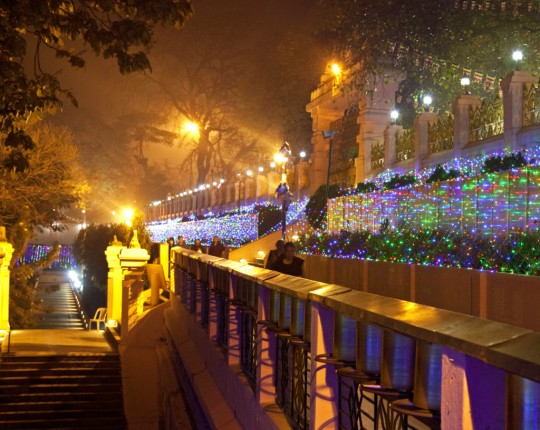
Lama Zopa Rinpoche doing korwa at the Mahabodhi Temple, Bodhgaya, India, March 2014. Photo by Andy Melnic.
“… On the basis of [reflecting on the lam-rim], we should generate the good heart, bodhichitta, the thought of benefiting others. This is our best refuge, especially for those of us whose lives are very busy, who don’t have much time for sitting or other traditional forms of practice. On the basis of reflecting on impermanence and death, we should make the good heart the main object of refuge in our lives. This allows all our actions to become Dharma, the cause of enlightenment and the cause of happiness for all sentient beings. Therefore, we should lead our lives with this attitude, the thought of benefiting all sentient beings.
“If you recite a Vajrasattva mantra once with bodhichitta you get the same benefit as you do from reciting 100,000 without it. If you make one light offering with bodhichitta, you get the same amount of merit as you do from making 100,000 light offerings without it. If you make charity of one dollar to a sentient being – a beggar or a homeless person – with bodhichitta, you get the same amount of merit as you do from making charity of $100,000 without it.
“It is said in the scriptures that if the sentient beings of three galaxies – the Tibetan term is tong-sum, but I’m not exactly sure how best to translate it, you should check for yourselves – all build stupas of the seven precious substances, such as gold, diamonds and so forth, and fill the whole world with these stupas, the merit of that is far less than that created by just one person offering a tiny flower to the Buddha with bodhichitta motivation. The person making this small offering with bodhichitta motivation creates far more merit than three galaxies of sentient beings covering the world with stupas made of the seven precious substances without it.
“Try to imagine this. If you build just one stupa you create unbelievable merit. It directs your life to enlightenment and is an amazing purification. So here we have three galaxies’ worth of sentient beings, each one building a stupa of the seven precious substances – not with bricks and mortar but with precious jewels – and covering the world with these. Nevertheless, the merit of one person offering a tiny flower to the Buddha with bodhichitta motivation creates far more merit than that.
“Thinking about this should inspire you to make bodhichitta your heart practice. It transforms your life like iron into gold or kaka into diamonds. Bodhichitta motivation gives your life its greatest possible meaning and makes every single action of your daily life as beneficial as it can possibly be. You should remember bodhichitta from morning to night, twenty-four hours a day. Hold it as your most precious possession, as your wish-fulfilling jewel. You should cherish your bodhichitta motivation above all else; remember it constantly and practice it at every moment. …”
– Lama Zopa Rinpoche, from The Joy of Compassion, “Chapter One: Living with Compassion,” published by the Lama Yeshe Wisdom Archive
Learn more about FPMT spiritual director Lama Zopa Rinpoche and his beneficial activities by visiting Rinpoche’s homepage, where you will find links to Rinpoche’s schedule, new advice, recent video, photos and more.
- Tagged: bodhichitta, lama zopa rinpoche, mandala
- 0
4
Extraordinary Aspirations

Lama Zopa Rinpoche giving an oral transmission of King of Prayers at Mahabodhi Stupa, Bodhgaya, India, February 2014. Photo by Ven. Sarah Thresher.
“… May my pure activities be endless,
My good qualities boundless,
And through abiding in immeasurable activity,
May I actualize infinite emanations.
“Limitless is the end of space,
Likewise, limitless are living beings,
Thus, limitless are karma and afflictions.
May my aspiration’s reach be limitless as well. …”
– From “King of Prayers,” published by FPMT Education Services
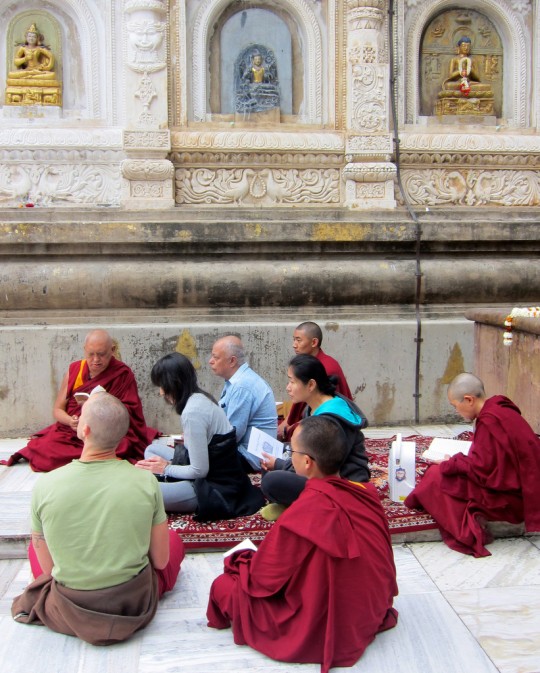
Lama Zopa Rinpoche giving an oral transmission of King of Prayers at Mahabodhi Stupa, Bodhgaya, India, February 2014. Photo by Ven. Sarah Thresher.
Lama Zopa Rinpoche is the spiritual director of the Foundation for the Preservation of Mahayana Tradition (FPMT), an organization dedicated to preserving Mahayana Buddhism through offering the Buddha’s authentic teachings and to facilitating reflection, meditation, practice and the opportunity to actualize and directly experience the Buddha’s teachings. Sign up to receive news and updates.
- Tagged: king of prayers, mandala
- 0
3
Lama Zopa Rinpoche with Khunu Lama Rinpoche’s Attendant

Lama Zopa Rinpoche with the attendant of the previous Khunu Lama Rinpoche, Bodhgaya, India, March 2014. Photo by Ven. Roger Kunsang.
While in Bodhgaya, Lama Zopa Rinpoche met with the attendant of the previous Khunu Lama Rinpoche. Known as the Ladkhi Gen-la, he has been teaching in Mumbai for the past 20 years.
Khunu Rinpoche, who passed away in 1977, was as a great teacher and scholar, called by His Holiness the Dalai Lama “the Shantideva of our time.” He authored Vast as the Heavens, Deep as the Sea: Verses in Praise of Bodhicitta, published by Wisdom Publications.
More information, photos and updates about FPMT spiritual director Lama Zopa Rinpoche can be found on Rinpoche’s homepage. If you’d like to receive news of Lama Zopa Rinpoche via email, sign up to Lama Zopa Rinpoche News.
- Tagged: khunu lama rinpoche, lama zopa rinpoche, mandala
- 0
2
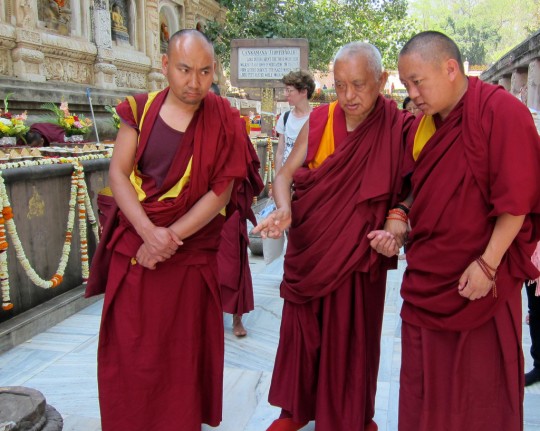
Lama Zopa Rinpoche circumambulating the Mahabodhi Stupa, Bodhgaya, India, March 2014. Photo by Ven. Sarah Thresher.
By Ven. Sarah Thresher
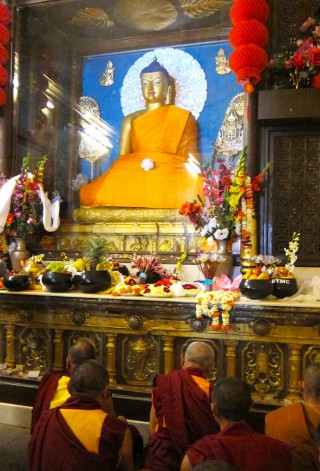
Lama Zopa Rinpoch making extensive prayers and dedications, Mahabodhi Stupa, Bodhgaya, India, March 2014. Photo by Ven. Sarah Thresher.
While Lama Zopa Rinpoche has been staying at Root Institute in Bodhgaya, India, he has been engaged in many practices during Losar and the two weeks that follow. Ven. Sarah Thresher has been participating in these virtuous activities and shared this report.
Rinpoche has gone nearly every day of the 15 miracle days to the stupa to do korwa [circumambulation], bless the light offerings and give the transmission of the Sutra of Golden Light.
On the Tibetan 15th, Chotrul Duchen, Rinpoche went to the stupa in the late morning after giving the Eight Mahayana Precepts at Root Institute. He did some circumambulation while reciting Lama Tsongkhapa’s Lekshay Nyingpo and then offered robes and bowls full of fruit and other offerings to the Buddha statue in the main shrine with extensive prayers and dedications for all the students and benefactors in the organization, for world peace, for all the centers and projects and for all sentient beings.
It’s very important to Rinpoche not to waste a moment of opportunity to purify and accumulate merit with this precious human life and to always motivate with bodhichitta and dedicate in the most extensive way for all sentient beings while remembering emptiness.
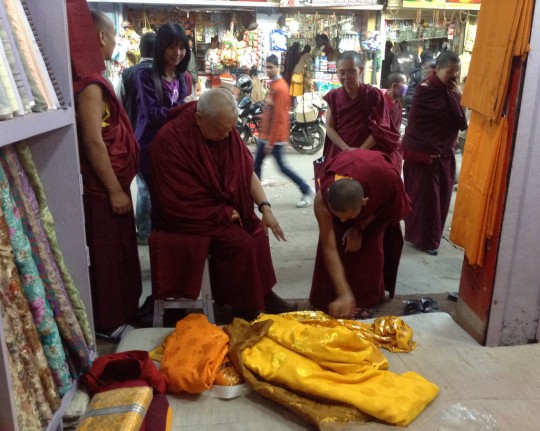
Lama Zopa Rinpoche in the market choosing the exact material to be offered to the Buddha statue inside the Mahabodhi Stupa, Bodhgaya, India, February 2014. Photo by Ven. Sarah Thresher.
Read more from Ven. Sarah Thresher on Rinpoche’s activities during Monlam.
Every month the Lama Zopa Rinpoche Bodhichitta Fund sponsors the offering of robes to the Buddha inside the Mahabodhi Stupa. Visit the fund’s website to learn more.
Learn more about Lama Zopa Rinpoche, spiritual director of the Foundation for the Preservation of Mahayana Tradition (FPMT), and Rinpoche’s vision for a better world. Sign up to receive news and updates.
- Tagged: bodhgaya, lama zopa rinpoche, mahabodhi stupa, mandala
- 0
1
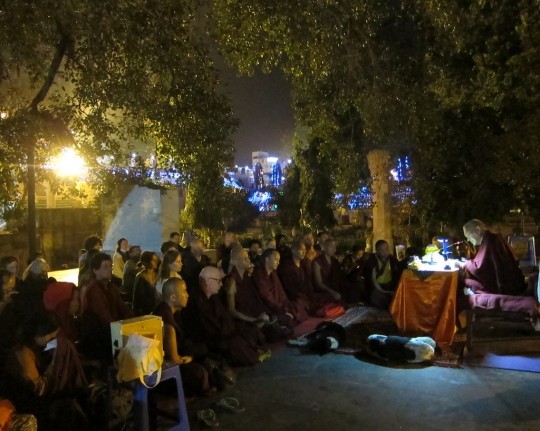
Lama Zopa Rinpoche giving oral transmission of Sutra of Golden Light at Mahabodhi Stupa, Bodhgaya, India, March 2014. Photo by Ven. Sarah Thresher.
By Ven. Sarah Thresher
While Lama Zopa Rinpoche has been staying at Root Institute in Bodhgaya, India, he has been engaged in many practices during Losar and the two weeks that follow. Ven. Sarah Thresher has been participating in these virtuous activities and shared this report.
Rinpoche has been giving the oral transmission of the Sutra of Golden Light during the two weeks following Losar at the Mahabodhi Stupa in Bodhgaya.
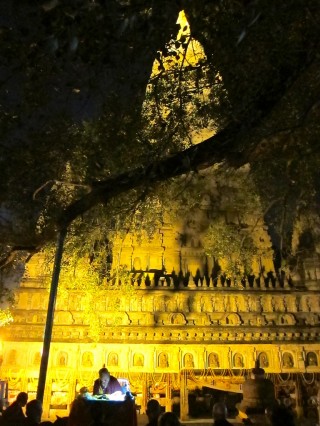
Mahabodhi Stupa with Lama Zopa Rinpoche and students, Bodhgaya, India, March 2014. Photo by Ven. Sarah Thresher.
The setting is stunning with a backdrop of the golden floodlit stupa and 100,000 multicolored light offerings around us.
Before the transmission Rinpoche does korwa [circumambulation] and blesses and offers the light offerings, which are part of Root Institute’s Festival of Lights and Merit. Rinpoche has commented many times how beautiful they are and also that people who are sponsoring them have so much in which to rejoice.
Then there is a motivation for the transmission, and we begin the journey through the marvelous world of the Sutra of Golden Light, with Rinpoche pausing now and then to translate some of the mind-blowing benefits of the sutra spoken by the buddhas, bodhisattvas, goddesses, deities, guardians, etc.
On one evening, Rinpoche quoted from Chapter 10 where the Goddess Drdha explains how simply listening to the Sutra of Golden Light delights hundreds of thousands of millions of buddhas, frees beings from the lower realms and causes beings to be born in the higher realms for hundreds of thousands of rebirths. The benefits come from hearing even one chapter, one four-line verse, one word or the name of the sutra.
Rinpoche told the story that he took a bite of food in Malaysia and felt a toothache, so he just remembered the Sutra of Golden Light and the pain disappeared.
“Whatever problem you have,” Rinpoche said, “just by thinking of the Sutra of Golden Light, your problem has gone. When you are experiencing black magic, spirit harm, sicknesses that doctors cannot cure and other problems, one very good solution is to recite the Sutra of Golden Light.” And this can also help in countries where there is a lot of fighting and problems.
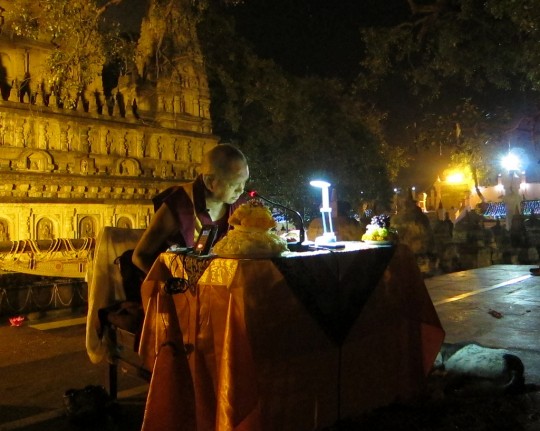
Lama Zopa Rinpoche giving oral transmission of Sutra of Golden Light at Mahabodhi Stupa, Bodhgaya, India, March 2014. Photo by Ven. Sarah Thresher.
Read more from Ven. Sarah Thresher on Rinpoche’s activities during Monlam.
Learn more about Lama Zopa Rinpoche, spiritual director of the Foundation for the Preservation of Mahayana Tradition (FPMT), and Rinpoche’s vision for a better world. Sign up to receive news and updates.
31
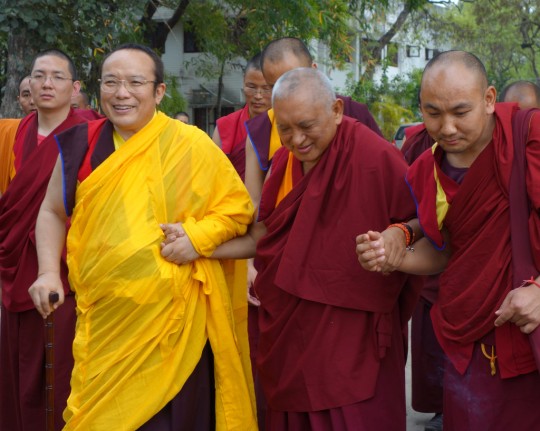
H. E. Tai Situ Rinpoche and Lama Zopa Rinpoche on Maitreya Project land, Bodhgaya, India, March 2014. Photo by Ven. Roger Kunsang.
His Eminence the Twelfth Tai Situ Rinpoche visited the Maitreya Project land in Bodhgaya with Lama Zopa Rinpoche to make prayers for the success of the project.

Tai Situ Rinpoche and Lama Zopa Rinpoche making prayers in front of the 24-foot (7-meter) Maitreya Project statue, Bodhgaya, India, March 2014. Photo by Ven. Roger Kunsang.
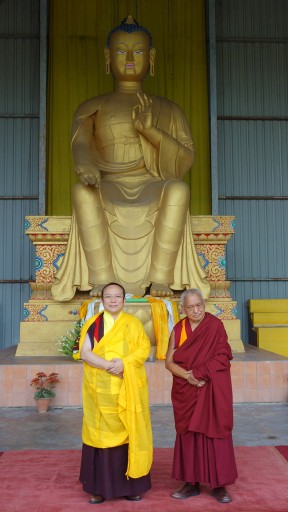
Tai Situ Rinpoche and Lama Zopa Rinpoche in front of the 24-foot (7-meter) Maitreya Buddha statue, Bodhgaya, India, March 2014. Photo by Ven. Roger Kunsang.
The Tai Situ is one of the oldest lineages in the Kagyü school and is considered to be an emanation of the bodhisattva Maitreya.
The Maitreya Project in Bodhgaya has been making progress. Currently, the project plans to build a large statue of Maitreya in his bodhisattva aspect (with legs crossed). The Maitreya Buddha Kushinagar Project is building a second very large Maitreya statue in the seated aspect.
For more, see Rinpoche’s letter on the Maitreya Projects and Mandala‘s coverage.
Lama Zopa Rinpoche is the spiritual director of the Foundation for the Preservation of Mahayana Tradition (FPMT), an organization dedicated to preserving Mahayana Buddhism through offering the Buddha’s authentic teachings and to facilitating reflection, meditation, practice and the opportunity to actualize and directly experience the Buddha’s teachings. Sign up to receive news and updates.
- Tagged: bodhgaya, lama zopa rinpoche, maitreya project bodhgaya, maitreya projects, mandala, tai situ rinpoche
- 0
28
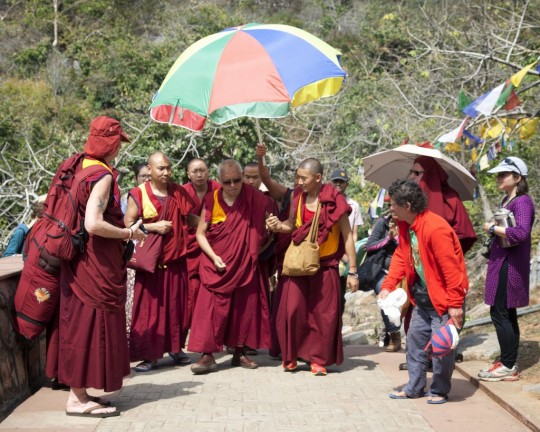
Lama Zopa Rinpoche walking up to Vulture’s Peak, India, March 2014. Photo by Andy Melnic.
“If you are performing the daily actions of your life with two attitudes, you are getting close to enlightenment. The two attitudes are: 1) having a sincere heart, doing social service with compassion (working for others); and, 2) meditating on the lam-rim (the gradual path to enlightenment). This may not mean actually meditating, but living your life with lam-rim, in order to purify and collect merit, and then on top of that practicing tantra, in order to achieve enlightenment quickly, or at least to prepare the mind, by leaving positive imprints every day. Social service means doing something for others, doing it from your heart. Even if it is only a little help that you give, you still get real satisfaction, like you have done something meaningful in your life. You have done something positive. Then, every day, every moment, every second, you are getting closer to enlightenment.

Lama Zopa Rinpoche making an offering to a beggar on the way up to Vulture’s Peak, India, March 2014. Photo by Andy Melnic.
“Otherwise, if you just live your life only thinking about your own pleasure, trying to achieve it for yourself, with attachment, then the main aim of your life is you. You are looking for pleasure for yourself, sexual pleasure and so forth, with attachment, and from this comes only pain. Everything just becomes painful.
“There is the pain of separation, where you can’t stand to be away from the person you are attached to. Then, each day, your feelings becomes stronger, until the attachment becomes unbearable. Then there comes the pain of jealousy toward others. You don’t want others to have a connection. You have so many worries and fears, and it becomes so much suffering.
“If your life does not have these two things in them (social service or lam-rim) then no matter how much you meditate, if it is not done with lam-rim, or by doing social service, doing work for others, then instead you are only doing it for yourself, and your whole life gets tied up with attachment, to sex and other things. Then there is nothing positive in your life, now or in the future. Your life will become dark, because your whole life is lived with the self-cherishing thought, with desire, attachment and clinging to this life, and all of these are non-virtues. So when you die, you don’t have any positive thoughts, and you are not able to renounce life. …”
– Lama Zopa Rinpoche, from “Dealing with Attachment” on “Lama Zopa Rinpoche’s Online Advice Book.”
Learn more about Lama Zopa Rinpoche, spiritual director of the Foundation for the Preservation of Mahayana Tradition (FPMT), and Rinpoche’s vision for a better world. Sign up to receive news and updates.
- Tagged: attachment, lama zopa rinpoche, mandala
- 0
27
Rinpoche with Sangha on Vulture’s Peak
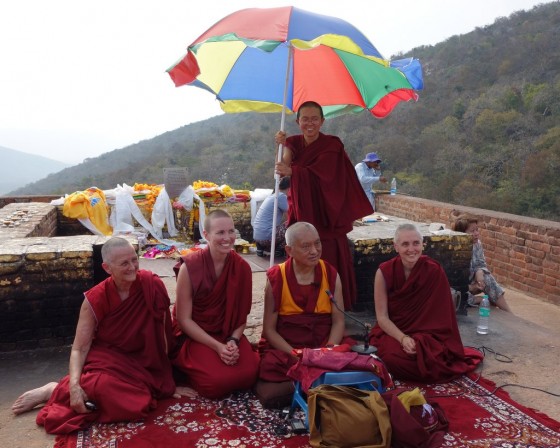
Lama Zopa Rinpoche with nuns at Vulture’s Peak, India, March 2014. Photo by Ven. Roger Kunsang.
During Monlam, Lama Zopa Rinpoche traveled from Bodhgaya to Rajgir and walked up to Vulture’s Peak. Rinpoche gave an oral transmission of the Vajra Cutter Sutra to Sangha and lay students who had traveled from Bodhgaya with Rinpoche.
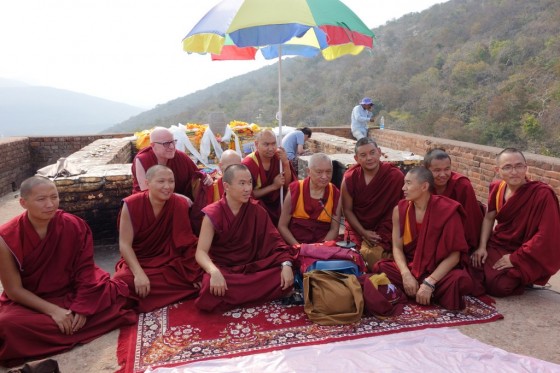
Lama Zopa Rinpoche with monks at Vulture’s Peak, India, March 2014. Photo by Ven. Roger Kunsang.
Lama Zopa Rinpoche is the spiritual director of the Foundation for the Preservation of Mahayana Tradition (FPMT), an organization dedicated to preserving Mahayana Buddhism through offering the Buddha’s authentic teachings and to facilitating reflection, meditation, practice and the opportunity to actualize and directly experience the Buddha’s teachings. Sign up to receive news and updates.
- Tagged: lama zopa rinpoche, mandala, sangha, vajra cutter sutra, vulture's peak
- 0
26
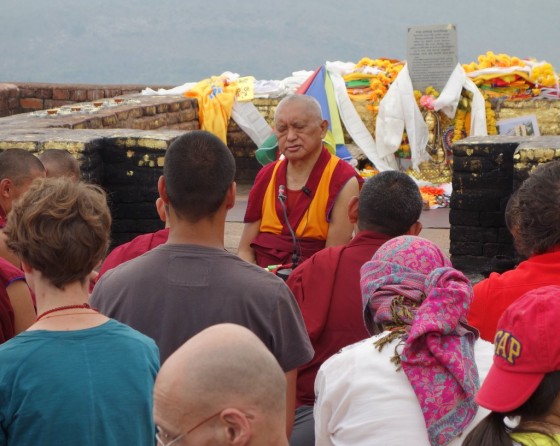
Lama Zopa Rinpoche giving an oral transmission of the Vajra Cutter Sutra on Vulture’s Peak, India, March 2014. Photo by Ven. Roger Kunsang.
“The Vajra Cutter Sutra is unbelievable. It is one of the most profitable practices because the root of all sufferings, yours and others, is the ignorance holding ‘I’ as truly existent, even though it is empty of that; and the ignorance holding the aggregates as truly existent, even though they are empty of that. The only antidote to cut that, to get rid of that and through which to achieve liberation, the total cessation of the suffering causes – delusions and karma – is the wisdom realizing emptiness. This is the subject of the Vajra Cutter Sutra, emptiness. So, each time you read it, it leaves such a positive imprint. Without taking much time, without much difficulty, it is easy to actualize wisdom. …”
– Lama Zopa Rinpoche, from “The Benefits of Reciting the Vajra Cutter Sutra”
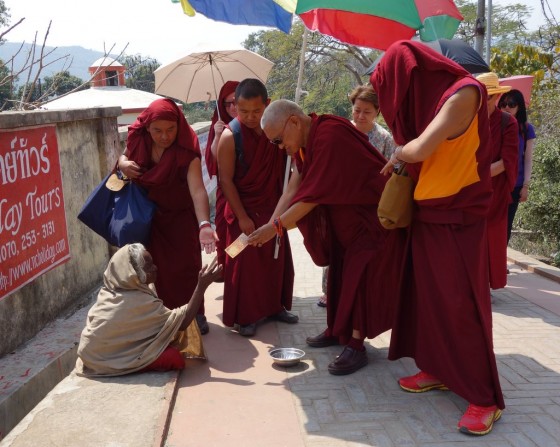
Lama Zopa Rinpoche visiting Rajgir and offering to the beggars on the way up to Vulture’s Peak, India, March 2014. Photo by Ven. Roger Kunsang.
Learn more about Lama Zopa Rinpoche, spiritual director of the Foundation for the Preservation of Mahayana Tradition (FPMT), and Rinpoche’s vision for a better world. Sign up to receive news and updates.
- Tagged: lama zopa rinpoche, mandala, vajra cutter sutra
- 0
25
Rinpoche’s Rooftop Altar
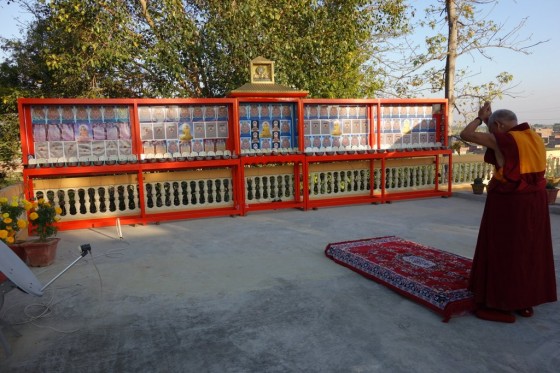
Lama Zopa Rinpoche prostrating in front of rooftop altar, Root Institute, Bodhgaya, India, March 2014. Photo by Ven. Roger Kunsang.
By Ven. Sarah Thresher
Lama Zopa Rinpoche has been staying at Root Institute in Bodhgaya, India, where he has been engaged in nonstop virtuous activities. Ven. Sarah Thresher was with Rinpoche in Bodhgaya and shares this report.
Rinpoche designed and commissioned an altar for the rooftop of his house at Root Institute. Not just one small altar filled with pictures, statues of buddhas, water bowl offerings and light offerings, but a series of altars that stretch the width of the rooftop. Rinpoche wanted people to see this new altar to get some ideas and inspiration. Holy objects are incredibly precious and if we don’t make full use of them, we are wasting our good fortune.
This is where Rinpoche does prostrations facing towards the Mahabodhi Stupa. Rinpoche does not always need assistance to do full length prostrations, but he has replaced the wooden prostration board with a mattress just in case.
UPDATE: Root Institute director Ven. Thubten Labdron wrote to Mandala that “Rinpoche said this altar is not just for Rinpoche. Anyone can come and do their prostration ngöndro on the roof (when Rinpoche is not in residence).”
You can read more from Ven. Sarah Thresher on Rinpoche’s activites in Bodhgaya online.
Learn more about Lama Zopa Rinpoche, spiritual director of the Foundation for the Preservation of Mahayana Tradition (FPMT), and Rinpoche’s vision for a better world. Sign up to receive news and updates.
- Tagged: holy objects, lama zopa rinpoche, mandala, prostrations, root institute, ven. sarah thresher
- 0
24
Rinpoche Teaches on Vajra Cutter Sutra on Vulture’s Peak
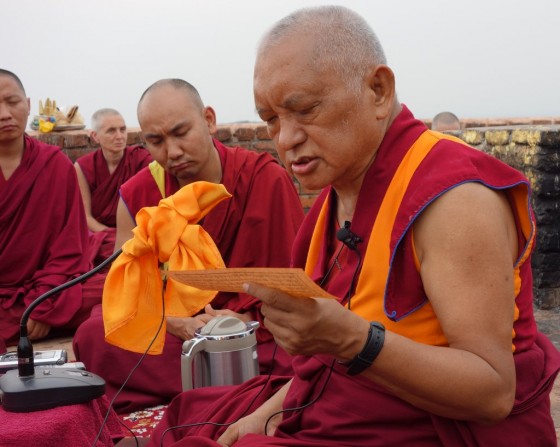
Lama Zopa Rinpoche giving an oral transmission of the Vajra Cutter Sutra on Vulture’s Peak, India, March 2014. Photo by Ven. Roger Kunsang.
During Monlam, Lama Zopa Rinpoche gave a teaching on and an oral transmission of the Vajra Cutter Sutra on Vulture’s Peak. According to Rinpoche’s assistant Ven. Roger Kunsang, Ven. Antonio Satta had requested this lung many years ago. Many Sangha members and students went with Rinpoche to Vulture’s Peak from Root Institute in Bodhgaya to receive the oral transmission.
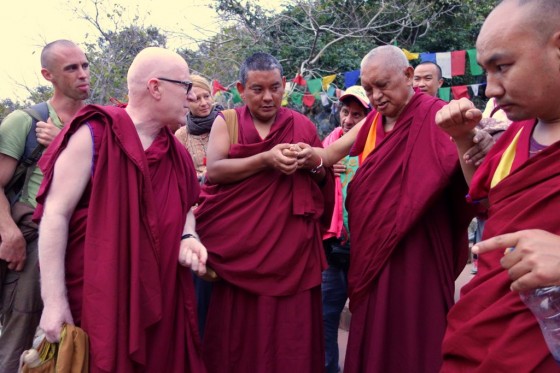
Ven. Antonio Satta (on left) debating with Lama Zopa Rinpoche on the “merely labeled” during the hike down from Vulture’s Peak, India, March 2014. Photo by Ven. Roger Kunsang.
Lama Zopa Rinpoche is the spiritual director of the Foundation for the Preservation of Mahayana Tradition (FPMT), an organization dedicated to preserving Mahayana Buddhism through offering the Buddha’s authentic teachings and to facilitating reflection, meditation, practice and the opportunity to actualize and directly experience the Buddha’s teachings. Sign up to receive news and updates.
- Tagged: lama zopa rinpoche, mandala, vajra cutter sutra, vulture's peak
- 0
21
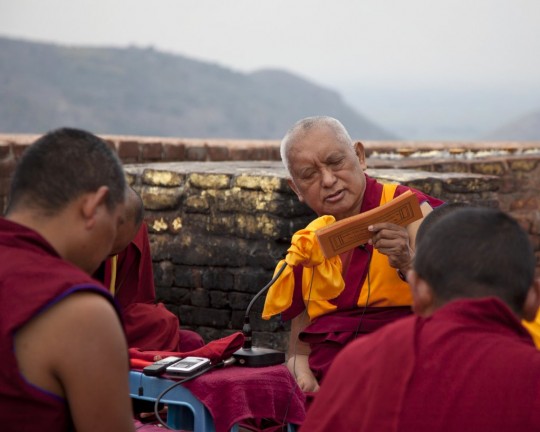
Lama Zopa Rinpoche giving the oral transmission of the Vajra Cutter Sutra on Vulture’s Peak, India, March 2014. Photo by Andy Melnic.
Lama Zopa Rinpoche, during the annual lam-rim course at Kopan in 2000, gave the oral transmission of the Heart Sutra and the Vajra Cutter Sutra. Here is an unedited transcript from the first day of teaching he offered at the course. In it, Rinpoche explains the importance of correctly understanding emptiness, which is the subject of the two sutras:
As I mentioned before, I’ll repeat again, we need to, must remove the imprint of delusion. For that, need to study teachings on emptiness, right view. Have to realize emptiness. Not just what people call “emptiness,” not just any kind of emptiness, what people call “emptiness,” even Dharma books – what anybody calls “emptiness,” not that. It has to be the right one. It has to be right one because the root of samsara, root of the suffering, only one very specific wrong concept, very specific wrong concept. There’s not many roots of samsara; there’s one typical, there’s one specific ignorance: even though the “I” exists in mere name, merely imputed by the mind, that’s how – it’s not that the “I” doesn’t exist. “I” exists. It exists being merely labeled by the mind. That’s how it exists. That’s what the “I” is. What is “I” is that. That’s all.
By realizing ultimate nature of “I,” after that, how you come to realize, by realizing absolute truth of the “I” then the next, as a result, you realize conventional truth of the “I.” How the “I” exists you come to know. You come to discover what is the “I.” How it exists you come to know that it exists being merely imputed by the mind.
So when you discover “I” this is how you see – other than that is an hallucination. “I” other than that, what we believe, what appears to us, totally hallucination, false “I.”
So, therefore, there’s a very specific root of suffering, ignorance: a concept. I’m not going to go into details. We allow our mind when – twenty-four hours our mind continuously impute “I.” Our mind imputes “I.” …
You can read the entire transcript of Lama Zopa Rinpoche’s teachings at the 33rd Kopan Course in November 2000 on the Lama Yeshe Wisdom Archive, which preserves the teachings of Lama Yeshe and Lama Zopa Rinpoche.
Learn more about Lama Zopa Rinpoche, spiritual director of the Foundation for the Preservation of Mahayana Tradition (FPMT), and Rinpoche’s vision for a better world. Sign up to receive news and updates.
- Tagged: emptiness, lama zopa rinpoche, mandala
- 0
- Home
- News/Media
- Study & Practice
- About FPMT Education Services
- Latest News
- Programs
- New to Buddhism?
- Buddhist Mind Science: Activating Your Potential
- Heart Advice for Death and Dying
- Discovering Buddhism
- Living in the Path
- Exploring Buddhism
- FPMT Basic Program
- FPMT Masters Program
- FPMT In-Depth Meditation Training
- Maitripa College
- Lotsawa Rinchen Zangpo Translator Program
- Universal Education for Compassion & Wisdom
- Online Learning Center
- Prayers & Practice Materials
- Overview of Prayers & Practices
- Full Catalogue of Prayers & Practice Materials
- Explore Popular Topics
- Benefiting Animals
- Chenrezig Resources
- Death & Dying Resources
- Lama Chopa (Guru Puja)
- Lama Zopa Rinpoche: Compendium of Precious Instructions
- Lama Zopa Rinpoche: Life Practice Advice
- Lama Zopa Rinpoche Practice Series
- Lamrim Resources
- Mantras
- Prayer Book Updates
- Purification Practices
- Sutras
- Thought Transformation (Lojong)
- Audio Materials
- Dharma Dates – Tibetan Calendar
- Translation Services
- Publishing Services
- Teachings and Advice
- Find Teachings and Advice
- Lama Zopa Rinpoche Advice Page
- Lama Zopa Rinpoche: Compendium of Precious Instructions
- Lama Zopa Rinpoche Video Teachings
- ༧སྐྱབས་རྗེ་བཟོད་པ་རིན་པོ་ཆེ་མཆོག་ནས་སྩལ་བའི་བཀའ་སློབ་བརྙན་འཕྲིན།
- Podcasts
- Lama Yeshe Wisdom Archive
- Buddhism FAQ
- Dharma for Young People
- Resources on Holy Objects
- Ways to Offer Support
- Centers
- Affiliates Area
- Teachers
- Projects
- Charitable Projects
- Make a Donation
- Applying for Grants
- News about Projects
- Other Projects within FPMT
- Support International Office
- Projects Photo Galleries
- Give Where Most Needed
- FPMT
- Shop
Subscribe to FPMT News
Translate*
*powered by Google TranslateTranslation of pages on fpmt.org is performed by Google Translate, a third party service which FPMT has no control over. The service provides automated computer translations that are only an approximation of the websites' original content. The translations should not be considered exact and only used as a rough guide.Buddhism is not at all a tactful religion, always trying to avoid giving offense. Buddhism addresses precisely what you are and what your mind is doing in the here and now. That’s what makes it so interesting.






